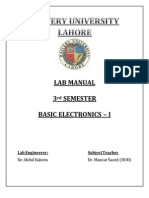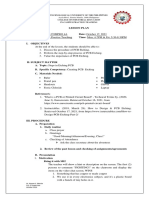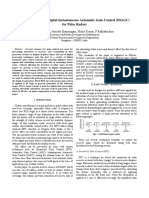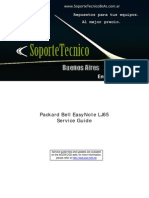Breadboard Activity
Breadboard Activity
Uploaded by
Vanjeff ZurcCopyright:
Available Formats
Breadboard Activity
Breadboard Activity
Uploaded by
Vanjeff ZurcOriginal Description:
Copyright
Available Formats
Share this document
Did you find this document useful?
Is this content inappropriate?
Copyright:
Available Formats
Breadboard Activity
Breadboard Activity
Uploaded by
Vanjeff ZurcCopyright:
Available Formats
CCS – Department of Computer Engineering Fundamentals of Electric Circuits
Nam e: __________________________________ Date: ____________________
Course, Yr., & Section: ___________________ Score: ___________________
General Instruction: Read the questions carefully. Any form of erasure and tampering is
considered wrong. Use ball pen with blue or black ink only.
M ATERIALS:
Analog/Digital Multi-meter
Breadboard and Solid Wire
DISCUSSIONS:
Proto-board/Breadboard
When building a “permanent circuit” the components can be grown together, soldered
together, or held together by screws and clamps. A prototyping breadboard allows you to
quickly build and test a circuit before constructing it more permanently. It is also known as
“solder-less” breadboard. Modern breadboards are made from plastic, and come in all shapes,
sizes, and even different colors. While larger and smaller sizes are available, the most common
sizes you will probably see are "full-size," "half-size," and "mini" breadboards. Most breadboards
also come with tabs and notches on the sides that allow you to snap multiple boards together.
PROCEDURES:
1. Test the internal connection of the breadboard by using the probes and continuity check
of the multi–meter.
2. Set your multi-meter to the continuity check symbol. Remember that this symbol might
not look the same on all multi-meters (and some multi-meters do not have it at all).
3. Insert the black and red probe into the holes for each given figure and observe the multi-
meter. Record your data on the given table.
Figure A:
Analog Digital
(0Ω or ∞) (beep or no beep)
Laboratory 2: Introduction to Breadboard 1 | P age
CCS – Department of Computer Engineering Fundamentals of Electric Circuits
Figure B:
Analog Digital
(0Ω or ∞) (beep or no beep)
Figure C:
Analog Digital
(0Ω or ∞) (beep or no beep)
Figure D:
Analog Digital
(0Ω or ∞) (beep or no beep)
Figure E:
Analog Digital
(0Ω or ∞) (beep or no beep)
Laboratory 2: Introduction to Breadboard 2 | P age
CCS – Department of Computer Engineering Fundamentals of Electric Circuits
Figure F:
Analog Digital
(0Ω or ∞) (beep or no beep)
Figure G:
Analog Digital
(0Ω or ∞) (beep or no beep)
Figure H:
Analog Digital
(0Ω or ∞) (beep or no beep)
QUESTIONS:
1. Refer to Line 1 of Figure I: Are the holes connected? Why?
______________________________________________________________________________
______________________________________________________________________________
2. Refer to Line 2 of Figure I: Is there a connection between ends of the arrow? Why?
______________________________________________________________________________
______________________________________________________________________________
Laboratory 2: Introduction to Breadboard 3 | P age
CCS – Department of Computer Engineering Fundamentals of Electric Circuits
3. Refer to Line 3 of Figure I: Are the holes conneted? Why?
______________________________________________________________________________
______________________________________________________________________________
4. Refer to Line 4 of Figure I: Is this row of holes conneted? Why?
______________________________________________________________________________
______________________________________________________________________________
5. Refer to Line 5 of Figure I: Is this column of holes conneted? Why?
______________________________________________________________________________
______________________________________________________________________________
Figure I:
Line 1 Line 2
Line 4
Line 3
Line 5
Laboratory 2: Introduction to Breadboard 4 | P age
CCS – Department of Computer Engineering Fundamentals of Electric Circuits
6. The figure below shows a basic circuit with a battery pack, an LED, and a resistor. Spot the
difference and encircle it. Which of the two figures will not work? Why?
______________________________________________________________________________
______________________________________________________________________________
“What is FAIL?”
FAIL is the…
F – irst A – ttempt I – n L – earning
7. Spot the difference on the figure below and encircle it. What is the reason why only the
LED on the left lights up?
______________________________________________________________________________
______________________________________________________________________________
Laboratory 2: Introduction to Breadboard 5 | P age
CCS – Department of Computer Engineering Fundamentals of Electric Circuits
8. Encircle the difference between these two circuits? Again, only the LED on the left lights
up. What is the problem?
______________________________________________________________________________
______________________________________________________________________________
9. Encircle the difference between the figures below. Elements on the left figure will not
work. What is the problem?
______________________________________________________________________________
______________________________________________________________________________
Laboratory 2: Introduction to Breadboard 6 | P age
You might also like
- For Iprog ProgramerDocument95 pagesFor Iprog ProgramerEsteban Quito50% (2)
- Accenture Assessment ScheduleDocument24 pagesAccenture Assessment Schedulepushpayandrapati97No ratings yet
- Computer Engineering Drafting and Design ModulesDocument188 pagesComputer Engineering Drafting and Design Modulesjohn blancoNo ratings yet
- Ms Excel Module 6Document14 pagesMs Excel Module 6R TECHNo ratings yet
- 4.2.2.7 Lab - Building An Ethernet Crossover CableDocument6 pages4.2.2.7 Lab - Building An Ethernet Crossover Cablerezhablo100% (2)
- Current and Future Challenges of Operating Systems Issues and ProblemsDocument9 pagesCurrent and Future Challenges of Operating Systems Issues and ProblemsDr-Muhammad RizwanNo ratings yet
- Battle of Breadboards: RulesDocument9 pagesBattle of Breadboards: RulesGaurav MukhiNo ratings yet
- Individual Circuit RubricDocument3 pagesIndividual Circuit Rubricapi-300676331No ratings yet
- Building Straight-Through and Crossover UTP CablesDocument7 pagesBuilding Straight-Through and Crossover UTP CablesPamitha100% (2)
- Introduction To The ICT ProgramDocument17 pagesIntroduction To The ICT ProgramcurlicueNo ratings yet
- Logic Circuits and Design Course Outline 311Document6 pagesLogic Circuits and Design Course Outline 311Jomar EscobidoNo ratings yet
- Making Ethernet Cables - Simple and Easy: How To Make An Ethernet CableDocument14 pagesMaking Ethernet Cables - Simple and Easy: How To Make An Ethernet CableJohn YohansNo ratings yet
- Power Supplies: Managing and Troubleshooting PcsDocument41 pagesPower Supplies: Managing and Troubleshooting PcsBima SenaNo ratings yet
- Tij1o0 Electronic Game Board Wiring and Soldering Rubric Fall 2017Document1 pageTij1o0 Electronic Game Board Wiring and Soldering Rubric Fall 2017api-308067286No ratings yet
- CPE Laws and Professional Practice Midterm ExamDocument8 pagesCPE Laws and Professional Practice Midterm Examxianchao801No ratings yet
- AST III ELectronics Symbols QUIZDocument4 pagesAST III ELectronics Symbols QUIZMylene Belotindos NableNo ratings yet
- CpE Laws and Professional Practice (Taskperformance Case Study)Document2 pagesCpE Laws and Professional Practice (Taskperformance Case Study)Kaito RanaNo ratings yet
- Module 3 Preparing For An Engineering CareerDocument14 pagesModule 3 Preparing For An Engineering CareerBSCPE1Angelo CuracheaNo ratings yet
- Resistor Color Coding LPDocument9 pagesResistor Color Coding LPAndrea BautistaNo ratings yet
- Numerical Methods SyllabusDocument3 pagesNumerical Methods SyllabusRodrigoNoaNo ratings yet
- SAG - Visual Graphics Design NC IIIDocument34 pagesSAG - Visual Graphics Design NC IIIT Jah NepNo ratings yet
- Technology and Livelihood Education-Network CablesDocument9 pagesTechnology and Livelihood Education-Network CablesAdelita Morales GombaNo ratings yet
- Core Competencies HahaDocument1 pageCore Competencies HahaNeil Joseph AlcalaNo ratings yet
- Lesson Plan - DemoDocument5 pagesLesson Plan - Demomarvin agubanNo ratings yet
- Creating Cross Over and Straight Through CablesDocument2 pagesCreating Cross Over and Straight Through CablesRenz SanchezNo ratings yet
- Syllabus HDL BEDocument3 pagesSyllabus HDL BEPraveen AndrewNo ratings yet
- Intro To NetworkingDocument29 pagesIntro To NetworkingQueniel QuezmarNo ratings yet
- Straight and Crossover CableDocument2 pagesStraight and Crossover CableAmarnath SahNo ratings yet
- Performance Task in Ict 10Document31 pagesPerformance Task in Ict 10Anon NetflixNo ratings yet
- Fundamentals of Electrical Circuits: Polytechnic University of The Philippines - Binan CampusDocument106 pagesFundamentals of Electrical Circuits: Polytechnic University of The Philippines - Binan CampusEsmeralda Joyce RaymundoNo ratings yet
- Digital Electronics Module 1Document23 pagesDigital Electronics Module 1Yuvraj SharmaNo ratings yet
- Question and AnswerDocument3 pagesQuestion and Answerrodel vargasNo ratings yet
- Joints and SplicesDocument1 pageJoints and SplicesesterlitaNo ratings yet
- Computer Engineering As Discipline (Unfinished)Document8 pagesComputer Engineering As Discipline (Unfinished)Angel Mhey F. BiloloNo ratings yet
- Enclosure 1 Gudelines On The RSTF 2019 PDFDocument7 pagesEnclosure 1 Gudelines On The RSTF 2019 PDFLouina Fernandez AtlasNo ratings yet
- CE1 Computer Engineering As A DisciplineDocument7 pagesCE1 Computer Engineering As A DisciplineSheran Manlongat BallesterosNo ratings yet
- Lab Manual 3 Semester Basic Electronics - I: Lab Engineerer: Subject TeacherDocument21 pagesLab Manual 3 Semester Basic Electronics - I: Lab Engineerer: Subject TeacherOmer Sheikh100% (1)
- Digital Citizenship Lesson On Responsibility RingsDocument3 pagesDigital Citizenship Lesson On Responsibility Ringsapi-317154257No ratings yet
- POP32i Sheet230316th enDocument28 pagesPOP32i Sheet230316th enGenInfo ServicesNo ratings yet
- 18Csc203J:Computer Organization and ArchitectureDocument56 pages18Csc203J:Computer Organization and ArchitectureSENTHIL RNo ratings yet
- Tle7 - 8-Ict-Programming For Robotics W7Document22 pagesTle7 - 8-Ict-Programming For Robotics W7Karen MartoniaNo ratings yet
- ICT 10 Q3 Week 2 f2f PDFDocument8 pagesICT 10 Q3 Week 2 f2f PDFChrishanelle Abong Sirius NohsNo ratings yet
- Rubric For Desoldering ProcessDocument1 pageRubric For Desoldering ProcessMerrylyn MiclatNo ratings yet
- Learning Area Grade Level Quarter Date I. Lesson Title Ii. Most Essential Learning Competencies (Melcs) Iii. Content/Core ContentDocument5 pagesLearning Area Grade Level Quarter Date I. Lesson Title Ii. Most Essential Learning Competencies (Melcs) Iii. Content/Core ContentYne AhuninNo ratings yet
- Technical Vocational Livelihood - ICTDocument22 pagesTechnical Vocational Livelihood - ICTPinagtongulan NHS (Region IV-A - Lipa City)100% (1)
- Summative Test in Computer Hardware ServicingDocument32 pagesSummative Test in Computer Hardware ServicingWhipple AnchetaNo ratings yet
- Possible Questions and Possible Answers For Css InterviewDocument4 pagesPossible Questions and Possible Answers For Css InterviewAllan TomasNo ratings yet
- Computer Networks and Security LaboratoryDocument1 pageComputer Networks and Security Laboratoryprince_kc2002No ratings yet
- Lesson PlanDocument5 pagesLesson PlanLM AlboNo ratings yet
- Sa Lesson Plan Feb2018Document3 pagesSa Lesson Plan Feb2018Vijayaraghavan AravamuthanNo ratings yet
- What Is Interaction Design?Document48 pagesWhat Is Interaction Design?SNTCC107CHAITANYA6826No ratings yet
- Social and Professional Issues Course Syllabus 2022Document29 pagesSocial and Professional Issues Course Syllabus 2022H A N ANo ratings yet
- Consumer Electronics or Home Electronics AreDocument12 pagesConsumer Electronics or Home Electronics AreBangaru BabuNo ratings yet
- Sample Personal Statement For Information TechnologyDocument2 pagesSample Personal Statement For Information Technologyapi-3816734No ratings yet
- This Is Subject For Revision. I Will Find Time To Finish This Thread. Stay Updated. I Will Provide Step by Step Procedure in Each Area. God Bless!Document3 pagesThis Is Subject For Revision. I Will Find Time To Finish This Thread. Stay Updated. I Will Provide Step by Step Procedure in Each Area. God Bless!Marvin OrbigoNo ratings yet
- Basic Electronics - PPT - Escorel - v2Document32 pagesBasic Electronics - PPT - Escorel - v2Noemie Claire EscorelNo ratings yet
- Syllabus EC5001 Embedded SystemsDocument3 pagesSyllabus EC5001 Embedded Systemskavish malakaNo ratings yet
- Electrical Schematic Diagram Guided NotesDocument3 pagesElectrical Schematic Diagram Guided Notes021521francisvrNo ratings yet
- 6002x FinalReview S2012Document77 pages6002x FinalReview S2012deepakhimmatNo ratings yet
- You Are Required To Answer All Sections: ST - Ignatius College Secondary Boys', Qormi Half-Yearly Examinations 2010/2011Document7 pagesYou Are Required To Answer All Sections: ST - Ignatius College Secondary Boys', Qormi Half-Yearly Examinations 2010/2011Josephine BriffaNo ratings yet
- Week 8 WorkshopDocument5 pagesWeek 8 Workshopnp01cp4a220332No ratings yet
- Infineon IRFL014N DataSheet v01 - 01 ENDocument9 pagesInfineon IRFL014N DataSheet v01 - 01 ENEliseu GonçalvesNo ratings yet
- AL - LHD8001 English ManualDocument20 pagesAL - LHD8001 English ManualJack_in_the_Box100% (1)
- Phaseo ABL7 - ABL8 - ABL7RP4803Document8 pagesPhaseo ABL7 - ABL8 - ABL7RP4803hicham boutoucheNo ratings yet
- Integrated Motor DrivesDocument10 pagesIntegrated Motor DrivesRaiyan TarekNo ratings yet
- A Novel Scheme of Digital Instantaneous Automatic Gain Control (DIAGC) For Pulse RadarsDocument5 pagesA Novel Scheme of Digital Instantaneous Automatic Gain Control (DIAGC) For Pulse RadarsFiZik 01No ratings yet
- 18a) Ground Distance RelaysDocument78 pages18a) Ground Distance RelaysRajesh Bodduna67% (3)
- GB 20914 DTH Service and Spares Charges BlackDocument1 pageGB 20914 DTH Service and Spares Charges BlackSatish KenguvaNo ratings yet
- Ec6311 - Analog and Digital CircuitsDocument176 pagesEc6311 - Analog and Digital Circuitsvijay cvijayNo ratings yet
- Basics of The RS 485 StandardDocument1 pageBasics of The RS 485 Standardmojsic6313No ratings yet
- What Is The Base Register and What Is The Limit Register?: SystemDocument9 pagesWhat Is The Base Register and What Is The Limit Register?: SystemGaby Mbugua80% (5)
- ANT-A264521R1v06-2508 DatasheetDocument2 pagesANT-A264521R1v06-2508 DatasheetDavid NigraNo ratings yet
- 1.introduction To P Es - NewDocument60 pages1.introduction To P Es - Newbarkat mughalNo ratings yet
- Interrupt: ECE473/573 Microprocessor System Design, Dr. Shiue 1Document25 pagesInterrupt: ECE473/573 Microprocessor System Design, Dr. Shiue 1shanty85No ratings yet
- 33 Service Manual - Packard Bell - Easynote Lj65Document217 pages33 Service Manual - Packard Bell - Easynote Lj65Soporte Tecnico Buenos AiresNo ratings yet
- Muratec F305 - 1350 Technical Support ManualDocument310 pagesMuratec F305 - 1350 Technical Support ManualRaymond CoonrodNo ratings yet
- Silicon On Insulator (SOI) Devices: Navakanta BhatDocument30 pagesSilicon On Insulator (SOI) Devices: Navakanta BhatVirendra MehtaNo ratings yet
- 8000 SeriesDocument2 pages8000 Seriesmostafa1alaahobaNo ratings yet
- Infineon IPT067N20NM6 DataSheet v02 01 EN-3398083Document12 pagesInfineon IPT067N20NM6 DataSheet v02 01 EN-3398083Achintya AsthanaNo ratings yet
- DXD g91Document10 pagesDXD g91IndoBlitz YTNo ratings yet
- Line Differential Protection Exercises: Siemens Power Academy TDDocument4 pagesLine Differential Protection Exercises: Siemens Power Academy TDAleksandar BognarNo ratings yet
- BCM21331Document2 pagesBCM21331pavlodeNo ratings yet
- Intel ChipsetDocument115 pagesIntel ChipsetO. C.No ratings yet
- Charge Density in MOSDocument68 pagesCharge Density in MOSJay Chandra DharNo ratings yet
- 4 Glynn and Devlin An X Band Gan Pa Mmic For PDocument8 pages4 Glynn and Devlin An X Band Gan Pa Mmic For PRAJANo ratings yet
- Initial Condn1Document9 pagesInitial Condn1kshrushtibasavarajNo ratings yet
- 1000w InverterDocument7 pages1000w Invertermeerhamza0% (1)
- TecQuipment Controller CE120Document3 pagesTecQuipment Controller CE120Tamir ANo ratings yet
- DISTRO4 SpecificationsDocument2 pagesDISTRO4 SpecificationsAlejandro Ortiz AmayaNo ratings yet

























































































